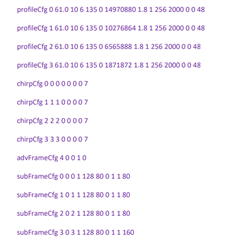Hi everyone,
I am working on the out-of-box demo and I was wondering about the possibility of implementing beam steering into the demo and if yes does it work by changing the value of the parameter TX phase shifter in the cfg file.
This thread has been locked.
If you have a related question, please click the "Ask a related question" button in the top right corner. The newly created question will be automatically linked to this question.
Hi everyone,
I am working on the out-of-box demo and I was wondering about the possibility of implementing beam steering into the demo and if yes does it work by changing the value of the parameter TX phase shifter in the cfg file.
Hi,
This use case hasn't been tested by TI, however, I think it should be possible to program a single chirp, enable all TX's and program in the right phase values to accomplish this. You can start by trying to enable all TX's in a single chirp and seeing how the OOB demo performs.
Regards,
Aayush
Hi Aayush,
I tried to enable all TX's in a single chirp like you told me by using this configuration which I found in ti/mmwave_industrial_toolbox_4_8_0/labs/long_range_people_detection/68xx_long_range_people_det/docs/Beamforming_in_LRPD page 4

this is the config file I loaded into the mmwave visualizer :
%This file was updated by script C:\ti\mmwave_sdk_03_05_00_04\packages\ti\demo\xwr18xx\mmw\profiles\mmwDemo_xwr18xx_update_config.pl version:1.1
%This file is compatible with Visualizer Version:3.5.0
% Carrier frequency GHz 77
% Ramp Slope MHz/us 100
% Num ADC Samples 256
% ADC Sampling Rate Msps 7.2
% ADC Collection Time us 35.56
% Extra ramp time required (start time) us 7
% Chirp time (end time - start time) us 36
% Chirp duration (end time) us 39
% Sweep BW (useful) MHz 3555.56
% Total BW MHz 3900
% Max beat freq (80% of ADC sampling rate) MHz 5.76
% Max distance (80%) m 8.64
% Range resolution m 0.042
% Range resolution (meter per 1D-FFT bin) m/bin 0.042
%
% Inter-chirp duration us 7
% Number of chirp intervals in frame - 64
% Number of TX (TDM MIMO) 2
% Number of Tx elevation antennas 1
% Number of RX channels - 4
% Max umambiguous relative velocity kmph 38.11
% mileph 23.82
% Max extended relative velocity kmph 76.23
% mileph 47.64
% Frame time (total) ms 2.944
% Frame time (active) ms 2.496
% Range FFT size - 256
% Doppler FFT size - 32
% Radar data memory required KB 272
% Velocity resolution m/s 0.66
% Velocity resolution (m/s per 2D-FFT bin) m/s/bin 0.66
% Velocity Maximum m/s 10.59
% Extended Maximum Velocity m/s 21.17
% Maximum sweep accorss range bins range bin 0.74
%
sensorStop
flushCfg
dfeDataOutputMode 3
channelCfg 15 7 0
adcCfg 2 1
adcbufCfg -1 0 1 1 1
lowPower 0 0
profileCfg 0 77 7 3 39 0 14970880 100 1 256 7200 0 0 30
profileCfg 1 77 7 3 39 0 10276864 100 1 256 7200 0 0 30
profileCfg 2 77 7 3 39 0 6565888 100 1 256 7200 0 0 30
profileCfg 3 77 7 3 39 0 1871872 100 1 256 7200 0 0 30
chirpCfg 0 0 0 0 0 0 0 7
chirpCfg 1 1 1 0 0 0 0 7
chirpCfg 2 2 2 0 0 0 0 7
chirpCfg 3 3 3 0 0 0 0 7
advFrameCfg 4 0 0 1 0
subFrameCfg 0 0 0 1 32 100 0 1 1 100
subFrameCfg 1 0 1 1 32 100 0 1 1 100
subFrameCfg 2 0 2 1 32 100 0 1 1 100
subFrameCfg 3 0 3 1 32 100 0 1 1 100
guiMonitor -1 1 1 1 0 0 1
cfarCfg -1 0 2 8 4 3 0 15.0 1
cfarCfg -1 1 0 4 2 3 1 15.0 1
multiObjBeamForming -1 1 0.5
calibDcRangeSig -1 0 -5 8 256
clutterRemoval -1 0
compRangeBiasAndRxChanPhase 0.0 1 0 1 0 1 0 1 0 1 0 1 0 1 0 1 0 1 0 1 0 1 0 1 0
measureRangeBiasAndRxChanPhase 0 1. 0.2
aoaFovCfg -1 -90 90 -90 90
cfarFovCfg -1 0 0.25 8.64
cfarFovCfg -1 1 -10.59 10.59
extendedMaxVelocity -1 0
CQRxSatMonitor 0 3 11 121 0
CQSigImgMonitor 0 127 8
analogMonitor 0 0
lvdsStreamCfg -1 0 0 0
calibData 0 0 0
sensorStart
the problem is that it does not detect any value of Z ( all points detected possess z = 0 almost)
any help ?
Hi Wajih,
With all TX's enabled, you will not be able to gather elevation information. The behavior would be similar to having a single transmit antenna, that is, the benefit of having multiple TX's in terms of extra virtual antennae (including elevation antennae) will be lost. In your chirp configuration, each subframe has a single chirp programmed. The single chirp enables all 3TX's at the same time. So, the configuration you have is of 4 RX antenna acting as 4 azimuth antennas. There are no virtual elevation antennas.
There will be 4 RX antenna still capable of discerning azimuth information, but as there is no dedicated elevation virtual antennae, you will not get elevation information
Regards,
Aayush